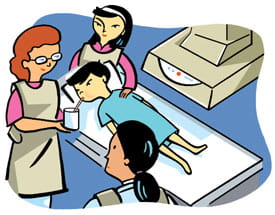The UGI with small bowel series test is done at the Department of Pediatric Radiology of Children’s Hospital. In the examination room will be a pediatric radiology doctor, who will be taking the X-ray pictures of your child's upper gastrointestinal system, and an X-ray technologist, who will be helping the doctor. You will see an X-ray machine, a long table, and a television screen. You might explain to your child that the X-ray machine is a large camera for taking pictures that will be shown on the screen. If your child has any questions, the doctor or X-ray technologist will be happy to answer them before the test.
Your child will be asked to take off his or her clothing and put on a hospital gown. When your child is ready, he or she will go into the fluoroscopy (floor-OS-co-pee) room and the test will begin.
- Your child will be awake during this test.
- Your child will be asked to lie down on the table.
- In the fluoroscopy room, your child will be given a milky liquid called barium in a cup to drink through a straw. This liquid allows the doctors to see the gastrointestinal system more clearly on the X-ray pictures. Barium looks like a milkshake, but does not have a pleasant taste. The doctor or X-ray technologist can add flavoring to the barium to make it taste better if your child wants it flavored.
- If your child is unable to drink the barium, a thin flexible tube may be placed through his or her nose to get the barium into the esophagus.
- As your child drinks the barium, the doctor will move the X-ray camera over your child. The camera will come close to, but not touch, your child.
- The doctor will begin to take the X-ray pictures as the barium is swallowed and passes through the esophagus into the stomach. Your child will be asked to continue to drink the barium while the doctor takes the X-ray pictures.
- The X-ray pictures will allow the doctor to watch the progress of the barium through the gastrointestinal system.
- Your child will be asked to roll from side to side while the doctor takes X-ray pictures.
- When the milky liquid moves to your child’s small intestine, the first part of the test, the UGI, is complete. Now the small bowel series will begin.
- Because the small bowel series tracks the progress of the barium through the entire small intestine, it usually takes two to three hours, or more, to complete. Your child may be given another cup of barium to drink. The barium can again be flavored if your child wants it.
- Your child will then be moved back to the waiting room. The X-ray technologist will periodically take your child to an X-ray room for a series of timed X-ray pictures of your child’s abdominal, or belly, area. These pictures will usually be taken anywhere from 15 minutes to one hour apart. You and your child will be able to return to the waiting room between these timed X-rays.
- When the X-rays show that the barium has gone through the entire small intestine, your child may have X-ray pictures taken of his or her terminal ileum (ILL-ee-um), which is where the large and small intestines meet.
- When the milky liquid moves through your child’s terminal ileum, the UGI with small bowel series test is complete.
As a parent, you may have concerns about radiation exposure. Children’s Hospital takes every precaution to make sure your child is safe.
- Our goal is to do the test correctly and thoroughly, while exposing your child to the smallest amount of radiation necessary to take the X-ray.
- Advances in equipment and film have lowered the amount of radiation your child will receive.
- All of the equipment is inspected regularly.
- Parts of the body that are not being X-rayed will be protected with a lead cover or apron when possible.









 At
At